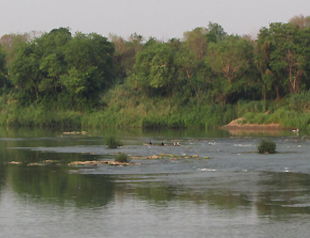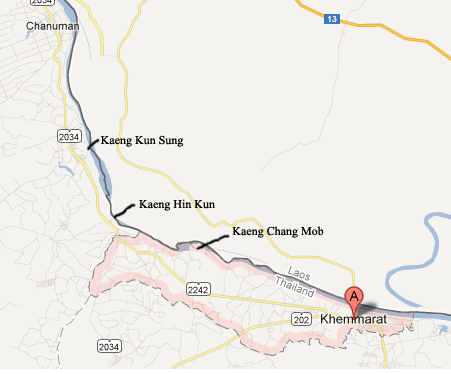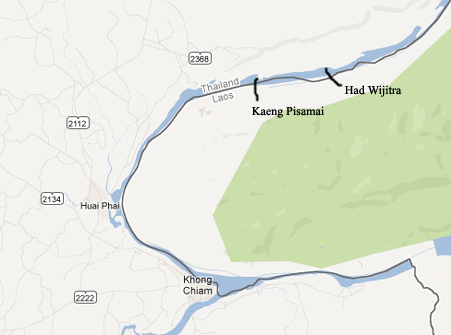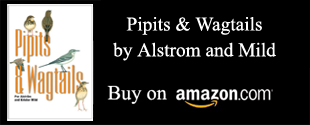
|
||||||||||
|
||||||||||
| Favorite Tweets by @thaibirding | ||||||||||
|
||||||||||
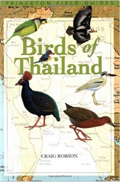 Buy Birds of Thailand on Amazon.co.uk |
||||||||||
| Site Map ; Contributors |
| The Mekong River In Ubon Ratchathani Province, 2nd-4th April 2013 | |||||||||||||
|
|||||||||||||
Tweet

|
|||||||||||||
| Introduction For some years I had been intrigued by a few sightings of the regionally endemic Mekong Wagtail made along the Mekong river in Ubon Ratchathani province in the far east of Thailand. I was not aware of more than a handful of sightings but when a new field guide to the birds of Thailand was published the range map for Mekong Wagtail showed it as resident for a whole stretch of the river in the lower northeast my interest became keener. I found myself with some free time in early April 2013 and heading in the general direction of Ubon Ratchathani so I decided to try and track down the bird for myself. Phil Round helpfully pointed me in the direction of a town called Khemmarat where he knew that observations had been made, so that was my point of reference. Armed with this information and the knowledge that Phil had seen Great Thick-knee in this area a few years ago I set off towards Khemmarat to see if I could get myself into suitable habitat and find either bird. |
|||||||||||||
|
|||||||||||||
| Notes
on Finding Birds As all the sites visited were open in their nature, actually spotting birds was easy. However, due to the intense heat at the time of our visit, bird activity was almost zero after 10am until about 4.30pm making it essential to be out very early and until dusk. |
|||||||||||||
| Field
Guides 1. A Field Guide to the Birds of South East Asia 2. Birds of Thailand |
|||||||||||||
| Birding
Highlights Kaeng Kun Sung: Mekong Wagtail Kaeng Chang Mob: Mekong Wagtail, Small Pratincole, Wire-tailed Swallow, River Lapwing Had Wijitra: Great Thick-knee, Mekong Wagtail, River Lapwing, Wire-tailed Swallow |
|||||||||||||
| Birding
Diary 2nd April We arrived in Khemmarat, in Ubon Ratchathani province, at about 2pm so I immediately tried to find the right rocky/sandy habitat in the river that might be home to the species I was searching for. Driving along the road that heads north to a town called Chanuman, after about 15 kms, I saw a sign, in English, pointing to an area of rapids in the river called "Kaeng Chang Mob". It was only 2 kilometres away so I drove down the road, into a small village, and after a couple of turns found myself overlooking a large area of sand dunes and rocks with patches of vegetation within the river Mekong. Much of the habitat here was quite close and some seemed accessible on foot due to the low water levels at this time of year, which is the end of the dry season. |
|||||||||||||
|
|||||||||||||
| About
7kms before reaching Chanuman a sign in Thai pointed towards Kaeng
Hin Kun which was also marked on my map. About 1km down the side road
I was at the bank of the Mekong but the river was very wide here and
whilst there were plenty of sand bars and rocks, it was all too far
away to be of much use. I took a look through my scope anyway and
could see some very distant Small Pratincoles and decent numbers of
Chinese Pond Herons and Little Egrets. Moving on towards Chanuman I crossed the provincial boundary into Amnat Charoen province and saw another sign in Thai to Kaeng Kun Sung. About 1.5kms down a small side road I found myself in a small parking area where several groups of Thai tourists were hiring rubber tubes to play in the river. This spot was on the bank of a smaller channel of the river and the distances were much more manageable for birding so I took a quick look through my binoculars out the car window and instantly spotted a wagtail on some small rocks. |
|||||||||||||
|
|||||||||||||
| After this we went to Chanuman where I managed to find an acceptable place to stay and a restaurant. However, there was time to have a quick look for a Thick-knee on some sandy/muddy/rocky areas out the front of the guesthouse. Unfortunately, most of the area was too overgrown to spot a bird like this from the bank, but there was a track out into the area and it was fairly undisturbed and may have harboured a Thick-knee. Certainly there was more riverine habitat here and further upstream according to my map. | |||||||||||||
|
|||||||||||||
| 3rd
April I was out of bed at about 6.15am and took a look around the area around the guesthouse and the river front. I did not see anything particularly noteworthy but there were nice numbers of species including Yellow-vented Bulbul, Brown-throated Sunbird, Eastern Stonechat, Pied Bushchat, Green Bee-eater, Chestnut-capped Babbler and a few nesting Baya Weavers. My next stop was Kaeng Hin Kun where the birds were still to far away to make much out of apart from about 50 Lesser Whistling Ducks, a few Black-winged Stilts, some Small Pratincoles and a couple of Great Egrets, Little Egrets and Chinese Pond Herons. However, we did manage to get a bowl of noodles for breakfast here! Although I had obtained the best views of Mekong Wagtail at Kaeng Kun Sung, there did not seem to be the prospect of seeing very much more there as the area of habitat was small, so I decided to spend the rest of the morning exploring the huge area of rocks, sand, mud and vegetation at Kaeng Chang Mob a few kilometres back towards Khemmarat. |
|||||||||||||
|
|||||||||||||
| We
kept driving until almost reaching Pa Taem national park but I saw
a sign to "Had Wijitra" a few kilometres before the park
gate. "Had" is the Thai word for beach, so this indicated
another place to access the river where there was sandy habitat. Following
the road for about 3-4 kms we followed another sign for the beach
and found ourselves in the car park of a guesthouse where we could
park and overlook the river, beach and more rocky outcrops. It was
still a bit early in the afternoon for birding and decided to look
around a bit more and found another guesthouse back downstream that
was more to our liking; we checked in there. This guesthouse overlooked
another large area of rocks, known as Kaeng Pisamai. From around 4-5pm
I explored this area. It started off well with a River Lapwing and
some Little Ringed Plovers plus lots of Wire-tailed Swallows which
were nesting in the rock formations but a lot of climbing and sweating
produced very few birds indeed. Deciding that the sandy habitat at
Had Wijitra looked better we drove the few kilometres back there. We descended to the beach and slowly walked upstream along it, onto some dunes. Very quickly I heard a wagtail and soon spotted a pair of Mekong Wagtails perched on some small rocks not far away. As I was watching these, a third bird attacked them but was chased off by the pair! We walked perhaps half a kilometre upstream, perhaps not even that and I started scanning the rocks and sand on the Laos side of the river; the time was about 5.30pm. I spotted a couple of River Lapwings then some giant shorebird running around on the rocks - a Great Thick-knee!!!!! Even though I was hoping to find this species, which is now very rare in South East Asia, I was still surprised to actually see one. We were quite far away so we walked a few hundred metres closer and obtained really nice 'scope views. Both my wife and I enjoyed looking at this bird but imagine my surprise when two more Great Thick-knees chased the first bird away to the Thai side of the river; now I could put Great Thick-knee on my Thai list without feeling a fraud. We watched the Great Thick-knees until sunset and returned to the guesthouse for dinner. |
|||||||||||||
|
|||||||||||||
| 4th
April This morning we decided to go for a boat trip along the river. Leaving at 7.30am we headed upstream in a narrow, long-tail boat with a canopy to protect us from the sun. The boat was going too fast really for birding, but having seen the target species already I was happy just to enjoy the ride and look at the scenery. |
|||||||||||||
| Summary One of the things I was concerned about before heading to the Mekong river in Ubon Ratchathani province was that it would be difficult to get to any suitable habitat to find both Mekong Wagtail and Great Thick-knee, however, it is fact easy to find many access spots to the river and excellent habitat, at least in the dry season. There was little information available as to how abundant Mekong Wagtail would be in Thailand and the low number of sightings would imply that it was a rare bird. However, the fact that I found a total of nine birds at four separate locations would indicate that I was either extremely lucky or that the species is actually far more common in this region than previously realized and the low number of sightings is down to the fact that few birders make the journey out to this part of Thailand. Given that there is a lot of suitable habitat and that I found three Great Thick-knees with very little effort, I suspect that this species is perhaps easier to find than may have been previously thought too and that if other birders visit the region they would have a good chance of finding both birds. |
|||||||||||||
| Nick Upton (nickupton@thaibirding.com) | |||||||||||||
| Species list with notes | |||||||||||||
| Chanuman:
Ch Kaeng Kun Sung: KKS Kaeng Hin Kun: KHK Kaeng Chang Mob: KCM Kaeng Sam Pan Bok: KSPB |
Kaeng
Pisamai: KPS Had Wijitra: HW Kaeng Gao Pan Bok: KGPB Two Colours River: TCR Pak Mun Dam: PMD |
||||||||||||
| 1.
Lesser Whistling Duck: 30+ at KHK. |
38. Black-naped Oriole: 1
at KSPB. 39. Ashy Minivet: A few at KPS. 40. Ashy Drongo: 1 at KHK. 41. Black Drongo: A few at KCM. 42. Common Iora: 2 at KHK & 2 at KCM. 43. Blue Rock Thrush: 2 at KGPB. 44. Oriental Magpie Robin: A few sites. 45. Stejneger's Stonechat: 1f at Ch. 46. Pied Bushchat: A few at Ch, KCM, KSPB, KPS, HW, KGPB & TCR. 47. Common Myna: At a few sites. 48. White-vented Myna: At a few sites. 49. Ashy Woodswallow: A few at Ch. 50. Striated Swallow: About 8 at Ch & a few at KPS. 51. Barn Swallow: A few at all locations. 52. Wire-tailed Swallow: At all sites. 53. Sooty-headed Bulbul: A few at Ch & KCM. 54. Yellow-vented Bulbul: Ch, KCM, KHK & KSPB. 55. Streak-eared Bulbul: Common at Ch. 56. Grey-breasted Prinia: A few at KCM. 57. Yellow-bellied Prinia: 2 at KCM. 58. Bright-headed Cisticola: 1 at KCM. 59. Black-browed Reed Warbler: 1 at KCM. 60. Oriental Reed Warbler: 1 at KCM. 61. Common Tailorbird: A few at Ch & KCM. 62. Dark-necked Tailorbird: 1 at Ch. 63. Dusky Warbler: 1 at KCM. 64. Chestnut-capped Babbler: 2 at Ch. 65. Indochinese Bushlark: 2 at Ch & 1 at KHK. 66. Scarlet-backed Flowerpecker: 1m at Ch. 67. Brown-throated Sunbird: 2 at Ch, 1 at KHK, 1 at KSPB. 68. Little Spiderhunter: 1 at KH. 69. Mekong Wagtail: 2 at KKS, 3 at KCM, 3 at HW & 1 at PMD. 70. Yellow Wagtail: 1 at KCM. 71. House Sparrow: A few at Ch. 72. Plain-backed Sparrow: Many at KCM. 73. Eurasian Tree Sparrow: A few at Ch, KHK, KPS. 74. Baya Weaver: About 20 at Ch. 75. White-rumped Munia: About 5 at KCM. 76. Scaly-breasted Munia: A few at KCM & KPS. |
||||||||||||
| Nick Upton can be contacted at nickupton@thaibirding.com | |||||||||||||
| If you are interested in arranging a bird watching tour you can see some suggested itineraries here - Birdwatching Trips - and you can contact me at the above email address to discuss the best options. | |||||||||||||
 |
|||||||||||||
| Photos from the trip | |||||||||||||
|
|||||||||||||
|
|||||||||||||
Tweet
 |
|||||||||||||

A Guide to Birdwatching in Thailand. Copyright © 2004-2017 thaibirding.com. All rights reserved.


